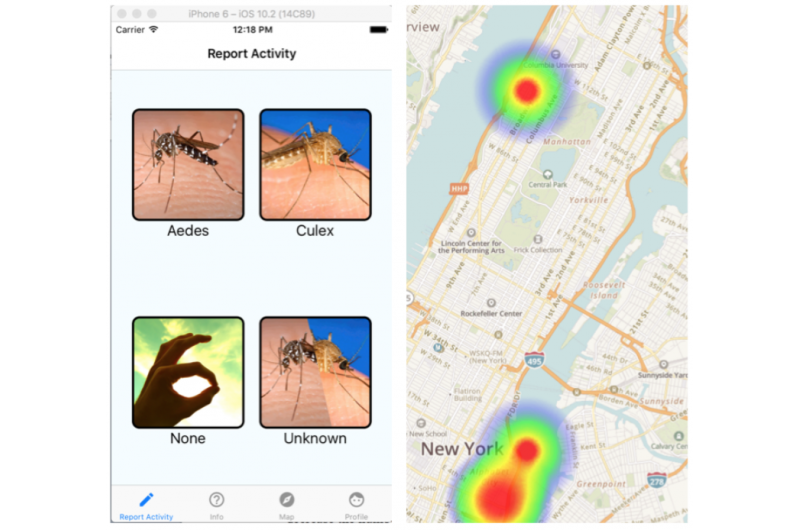Track mosquitoes with your smartphone

During my first summer in New York City, mosquitoes bit me mercilessly. Eventually I learned which parks and gardens to avoid, but I was struck by the large geographic variation in mosquito prevalence. Interested in whether the city made any data about mosquitoes publicly available, I learned that the city only had 52 permanent mosquito traps, roughly one per 6 square miles. For reference, the Upper West Side, Upper East Side and Central Park combined take up less than 5 square miles. Moreover, the majority of the trapping locations in NYC are within parks. Vector control officials either do not have the resources or the legal authority to trap mosquitoes in many locations, particularly homeowner backyards.
The annoyance of mosquito bites, combined with the serious threat they pose as vectors of infectious diseases, led me to wonder what could be done. Mosquito control requires active citizen engagement to monitor standing water, open containers and remove litter. I remembered reading about the brigadistas in Nicaragua, a public health group and campaign that taught community leaders to work with their neighbors to eliminate mosquito breeding habitats (the brigadistas produced graphics, such as the one here). When the Earth Institute put out a request for proposals for smartphone applications to engage citizen scientists, I pulled together my ideas for an app to report mosquito activity and applied with Professor Jeffrey Shaman and PhD student Eliza Little. Once funded, Eliza tapped the talented Matt Brennan to implement our vision.
Introducing Bitebytes
We created a smartphone application called Bitebytes as a tool for citizens to report mosquito activity. Community participation using the smartphone app can help supplement expensive mosquito trapping. Crowd-sourced mosquito identification can be an additional source of information for monitoring and forecasting mosquito abundance anywhere that user engagement is high. Data generated from the app would allow cities to target key areas to reduce mosquito abundance, and thus control the potential for the spread of mosquito-borne diseases. In addition to gathering data and enhancing the city mosquito-monitoring network, the app can be used to educate the public on mosquitoes, the diseases mosquitoes transmit, and mosquito habitat control. We hope people will feel empowered by reporting mosquitoes and contributing to data collection in their city or county.
How you can use Bitebytes
You can now download Bitebytes free from iTunes; we hope to make an Android version in the future. In the first screen, select the mosquito that most resembles the one bothering you, or select unknown. Next, you can add more information. There will be a heat map showing all reporting activity, and information about mosquitoes in the northeastern U.S. and how to control them. Reports from the app will also be available on the Bitebytes website. The more mosquitoes you report, the more status you accrue within Bitebytes; for example, you may even be crowned the "Duke" of Central Park!
Hopes for Bitebytes
User-generated electronic data streams are increasingly incorporated into models of infectious diseases. Many user-generated data streams of infectious diseases are passive (through Twitter posts or Wikipedia searches); here citizens will need to download an app onto their smartphone and actively use it. Citizen monitoring for mosquitoes can be successfully implemented, however, and other mobile application reporting systems have been used in Nicaragua and Brazil, Europe, and Canada.
With public awareness of mosquito vectors and participation to decrease the number of these vectors, we can counter the public health risks of mosquito-borne diseases, while improving residents' quality of life and use of parks. Given the heightened awareness of mosquito-borne diseases due to the Zika outbreak, public uptake is likely to be high. Together with Eliza, Matt, and Jeff, we are excited to use the Bitebytes platform to engage with end users, both in vector control and the general public, on issues regarding surveillance, risk of infectious disease and education.
More information: Richard M. Garfield et al. Health education and community participation in mass drug administration for malaria in Nicaragua, Social Science & Medicine (1986). DOI: 10.1016/0277-9536(86)90241-8
Josefina Coloma et al. Dengue chat: A novel web and cellphone application promotes community-based mosquito vector control, Annals of Global Health (2016). DOI: 10.1016/j.aogh.2016.04.244
This story is republished courtesy of Earth Institute, Columbia University: blogs.ei.columbia.edu .



















